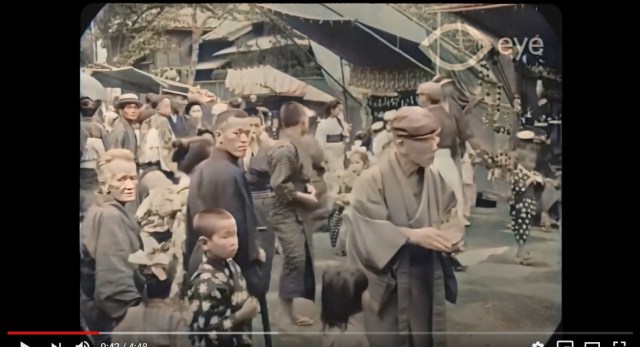
AI-restored video opens a hyper-realistic window to the Japan of a century ago.
Logically, we understand that people in the past were just as alive and active as we are today. Still, that sense is unavoidably dulled when looking at film from bygone eras. Gray-scale color, blurred focus, and movement that’s unnaturally sluggish or jerky all combine to make those glimpses into the past feel a little less real.
The opposite holds true too, though. Video restoration, machine learning specialist, and YouTube user Denis Shiryaev recently worked his digital magic on a series of film sequences shot in Tokyo between 1913 and 1915 that give us a much closer approximation of what the city looked like to the human eye of the time, and the result turns ordinary street scenes into a video overflowing with hyper-realism.
Shiryaev’s upgrades to the original film include a conversion to 60-frame-per-second movement and removing scratches, flickers, and other visual “noise.” AI neural network approximation processes then added color and facial feature restorations to create the sharp, smoothly moving images in the video.
Classic kimono and billowy hakama pants make up the majority of the Tokyoites’ fashions, and the gigantic framework shop a windchime merchant can be seen shouldering is another sign that this is the Japan of more than a century ago. Another mark of the times comes as numerous passers-by stop and stare in surprise right at the camera’s lens, since such technology was still a modern marvel in those days.
With Tokyo’s urban landscape having gone through multiple generations of change since the original film was shot, it’s hard to pick out exact locations, but the video clearly ends up at Sensoji Temple in the Asakusa neighborhood, which continues to be one of the most popular travel destinations in the city.
▼ The black-and-white version of the video (which has also had some video restoration work done and ambient sound added)
What makes the video especially fascinating is that it isn’t a showcase of high-ranking dignitaries or epoch-making events. Instead, it’s an honest glimpse at the people and lifestyles that define an era in quieter ways, and watching it has us not only thinking about the past, but wondering if any of our antics will end up being featured in the backgrounds of what the future of a hundred years from now sees as historical records.
Source: YouTube/Denis Shiryaev via Japaaan
Images: YouTube/Denis Shiryaev
● Want to hear about SoraNews24’s latest articles as soon as they’re published? Follow us on Facebook and Twitter!

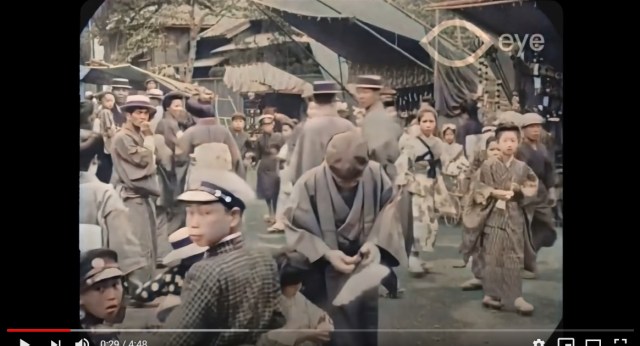
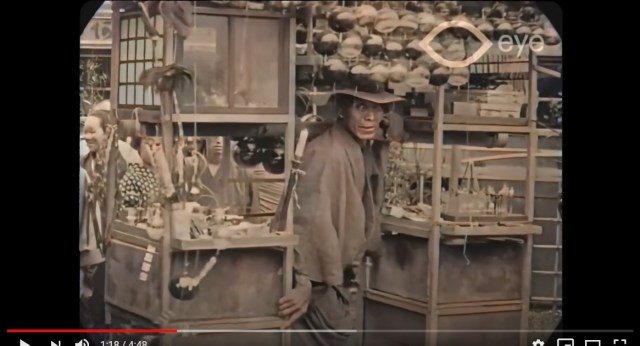
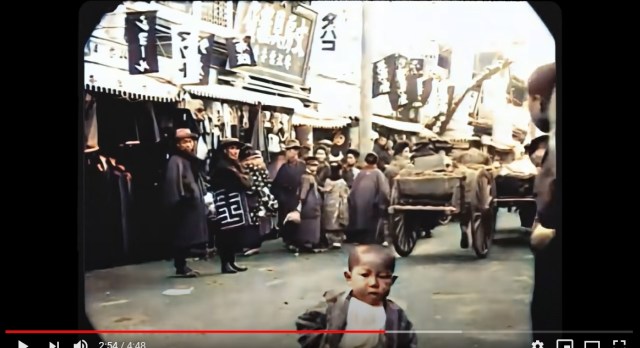
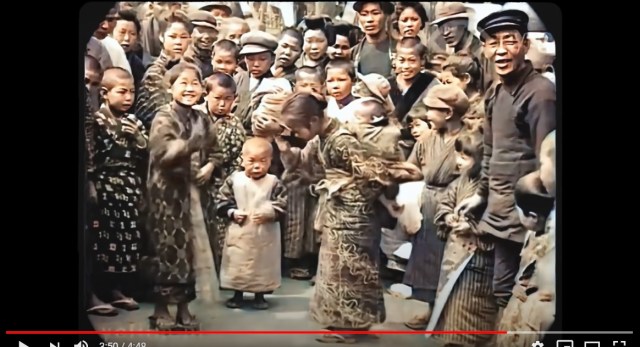
 These “star marks” on the road in Japan that indicate when to use your blinker are amazing【Video】
These “star marks” on the road in Japan that indicate when to use your blinker are amazing【Video】 This one guy has spent four years making an entire anime on a 3DS, and it looks amazing【Video】
This one guy has spent four years making an entire anime on a 3DS, and it looks amazing【Video】 New Attack on Titan game announces release month, continues to look really amazing 【Video】
New Attack on Titan game announces release month, continues to look really amazing 【Video】 Japanese fashion company brings modern-day samurai look to your legs with hakama chino pants
Japanese fashion company brings modern-day samurai look to your legs with hakama chino pants Miniature Kumamoto Castle exhibition lets you marvel at its remarkable architecture up close
Miniature Kumamoto Castle exhibition lets you marvel at its remarkable architecture up close Foreigner’s request for help in Tokyo makes us sad for the state of society
Foreigner’s request for help in Tokyo makes us sad for the state of society Seaside scenery, history, and so many desserts on Yokohama’s Akai Kutsu【Japan Loop Buses】
Seaside scenery, history, and so many desserts on Yokohama’s Akai Kutsu【Japan Loop Buses】 Red light district sushi restaurant in Tokyo shows us just how wrong we were about it
Red light district sushi restaurant in Tokyo shows us just how wrong we were about it Japanese city loses residents’ personal data, which was on paper being transported on a windy day
Japanese city loses residents’ personal data, which was on paper being transported on a windy day Japan’s summertime towelket pillowcases are even better with the addition of Ghibli stars【Photos】
Japan’s summertime towelket pillowcases are even better with the addition of Ghibli stars【Photos】 Should you add tartar sauce to Japanese curry rice? CoCo Ichi makes diners an unusual offer
Should you add tartar sauce to Japanese curry rice? CoCo Ichi makes diners an unusual offer Princesses, fruits, and blacksmiths: Study reveals the 30 most unusual family names in Japan
Princesses, fruits, and blacksmiths: Study reveals the 30 most unusual family names in Japan Suntory x Super Mario collaboration creates a clever way to transform into Mario【Videos】
Suntory x Super Mario collaboration creates a clever way to transform into Mario【Videos】 McDonald’s new Happy Meals offer up cute and practical Sanrio lifestyle goods
McDonald’s new Happy Meals offer up cute and practical Sanrio lifestyle goods Harajuku Station’s beautiful old wooden building is set to return, with a new complex around it
Harajuku Station’s beautiful old wooden building is set to return, with a new complex around it Japanese ramen restaurants under pressure from new yen banknotes
Japanese ramen restaurants under pressure from new yen banknotes French Fries Bread in Tokyo’s Shibuya becomes a hit on social media
French Fries Bread in Tokyo’s Shibuya becomes a hit on social media Studio Ghibli releases new action figures featuring Nausicaä of the Valley of the Wind characters
Studio Ghibli releases new action figures featuring Nausicaä of the Valley of the Wind characters New private rooms on Tokaido Shinkansen change the way we travel from Tokyo to Kyoto
New private rooms on Tokaido Shinkansen change the way we travel from Tokyo to Kyoto Tokyo Tsukiji fish market site to be redeveloped with 50,000-seat stadium, hotel, shopping center
Tokyo Tsukiji fish market site to be redeveloped with 50,000-seat stadium, hotel, shopping center Beautiful Ghibli sealing wax kits let you create accessories and elegant letter decorations【Pics】
Beautiful Ghibli sealing wax kits let you create accessories and elegant letter decorations【Pics】 Studio Ghibli releases Kiki’s Delivery Service chocolate cake pouches in Japan
Studio Ghibli releases Kiki’s Delivery Service chocolate cake pouches in Japan New definition of “Japanese whiskey” goes into effect to prevent fakes from fooling overseas buyers
New definition of “Japanese whiskey” goes into effect to prevent fakes from fooling overseas buyers Our Japanese reporter visits Costco in the U.S., finds super American and very Japanese things
Our Japanese reporter visits Costco in the U.S., finds super American and very Japanese things All-you-can-drink Starbucks and amazing views part of Tokyo’s new 170 meter-high sky lounge
All-you-can-drink Starbucks and amazing views part of Tokyo’s new 170 meter-high sky lounge More foreign tourists than ever before in history visited Japan last month
More foreign tourists than ever before in history visited Japan last month New Pokémon cakes let you eat your way through Pikachu and all the Eevee evolutions
New Pokémon cakes let you eat your way through Pikachu and all the Eevee evolutions Disney princesses get official manga makeovers for Manga Princess Cafe opening in Tokyo
Disney princesses get official manga makeovers for Manga Princess Cafe opening in Tokyo Sales of Japan’s most convenient train ticket/shopping payment cards suspended indefinitely
Sales of Japan’s most convenient train ticket/shopping payment cards suspended indefinitely Sold-out Studio Ghibli desktop humidifiers are back so Totoro can help you through the dry season
Sold-out Studio Ghibli desktop humidifiers are back so Totoro can help you through the dry season Japanese government to make first change to romanization spelling rules since the 1950s
Japanese government to make first change to romanization spelling rules since the 1950s Ghibli founders Toshio Suzuki and Hayao Miyazaki contribute to Japanese whisky Totoro label design
Ghibli founders Toshio Suzuki and Hayao Miyazaki contribute to Japanese whisky Totoro label design Doraemon found buried at sea as scene from 1993 anime becomes real life【Photos】
Doraemon found buried at sea as scene from 1993 anime becomes real life【Photos】 Tokyo’s most famous Starbucks is closed
Tokyo’s most famous Starbucks is closed One Piece characters’ nationalities revealed, but fans have mixed opinions
One Piece characters’ nationalities revealed, but fans have mixed opinions We asked a Uniqlo employee what four things we should buy and their suggestions didn’t disappoint
We asked a Uniqlo employee what four things we should buy and their suggestions didn’t disappoint Samurai Ninja Museum Tokyo With Experience is true to its name, lets you slice with real katana
Samurai Ninja Museum Tokyo With Experience is true to its name, lets you slice with real katana Crowd-funded hakama roomwear doubled its funding goal, is now available to everyone
Crowd-funded hakama roomwear doubled its funding goal, is now available to everyone Clever ad publicly shames commuters in real-time for “smartphone walking” in train station【Video】
Clever ad publicly shames commuters in real-time for “smartphone walking” in train station【Video】 Travel through Japanese festivals and tourist sites with this stunning 8K highlight reel 【Video】
Travel through Japanese festivals and tourist sites with this stunning 8K highlight reel 【Video】 Zhongshan man makes the catch of his life: a one-year-old child
Zhongshan man makes the catch of his life: a one-year-old child Emperor Akihito hints at abdication of throne in new video message
Emperor Akihito hints at abdication of throne in new video message New anime AI program animates your art for you when you add a voice clip【Videos】
New anime AI program animates your art for you when you add a voice clip【Videos】 300-year-old Tokyo comb company sells 30,000-yen wooden hair combs—Are they worth it?
300-year-old Tokyo comb company sells 30,000-yen wooden hair combs—Are they worth it? Stay home in style with Kyoto-easy hakama-inspired roomwear for men, women, and kids【Photos】
Stay home in style with Kyoto-easy hakama-inspired roomwear for men, women, and kids【Photos】 Fukuoka City aims to resume traffic at site of road collapse less than a week after accident
Fukuoka City aims to resume traffic at site of road collapse less than a week after accident Guardians of the Galaxy’s Gamora spotted sightseeing in Tokyo!【Video】
Guardians of the Galaxy’s Gamora spotted sightseeing in Tokyo!【Video】 Diarrhea-inducing mushrooms send three Japanese men to hospital after weekend-ruining barbecue
Diarrhea-inducing mushrooms send three Japanese men to hospital after weekend-ruining barbecue History’s worst job? Japanese noblewomen used to hire servants to take the blame for their farts
History’s worst job? Japanese noblewomen used to hire servants to take the blame for their farts Asakusa’s Sensoji temple shocks store owners with sudden 16-fold rent increase in shopping arcade
Asakusa’s Sensoji temple shocks store owners with sudden 16-fold rent increase in shopping arcade Samurai parkas for men feature traditional washi Japanese paper details
Samurai parkas for men feature traditional washi Japanese paper details
Leave a Reply